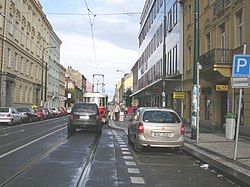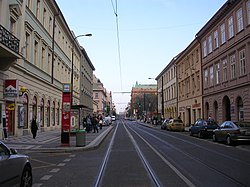Stop cap
The Haltestellenkap is a stop for public transport , the edge of which is pulled up to the continuous lane of road traffic or the traffic area of the tram . It is often the result of the renovation of bus bays and, in individual cases, symbolizes the priority of public transport.
The advantages of a stop cap include its short length and the option of stopping close to the curb (such as the Kassel special board ) to make it easier for passengers to change. Furthermore, especially with narrow road conditions, the erection of shelters is often only possible if the footpath is widened by stop caps; In addition, a bus stop cannot be parked by cars. The stopping vehicle also makes it easier for people entering and exiting to cross the lane. The combination of the stop cap and the crossing system makes sense . Furthermore, the bus or tram is at the top of the flow of vehicles when leaving the bus stop and there is no need to wait for a gap in the flowing traffic when leaving, this speeds up local public transport. A cape also results in a certain degree of traffic calming, as the stopping bus / tram briefly slows down the flow of traffic. Finally, compared to stopping bays, diagonal travel is avoided when arriving and departing, which increases safety for standing or getting on / off passengers. In addition, the cape can be used as a relatively large advertising space.
Compared to other types of bus stops (such as the bus bay ), it has the disadvantage that the rest of the traffic flow is disrupted, especially when there are several bus stops in a row. Therefore, the application limits should be at a decisive traffic volume of 1500 vehicles / h and a vehicle cycle of over ten minutes.
Stop caps are not suitable if vehicles have to wait for a long time, for example at connection points or terminal stops.
Norms and standards
- Recommendations for public transport systems (EAÖ)
- Guidelines for the construction of city streets (RASt)
Individual evidence
- ^ Research Society for Roads and Transport (Ed.): Definitions, part: traffic planning, road design and road operation . FGSV Verlag, Cologne 2000, p. 69 .
- ^ Günter Wolf: Road planning . Werner Verlag, Munich 2005, ISBN 3-8041-5003-9 , pp. 294 .

